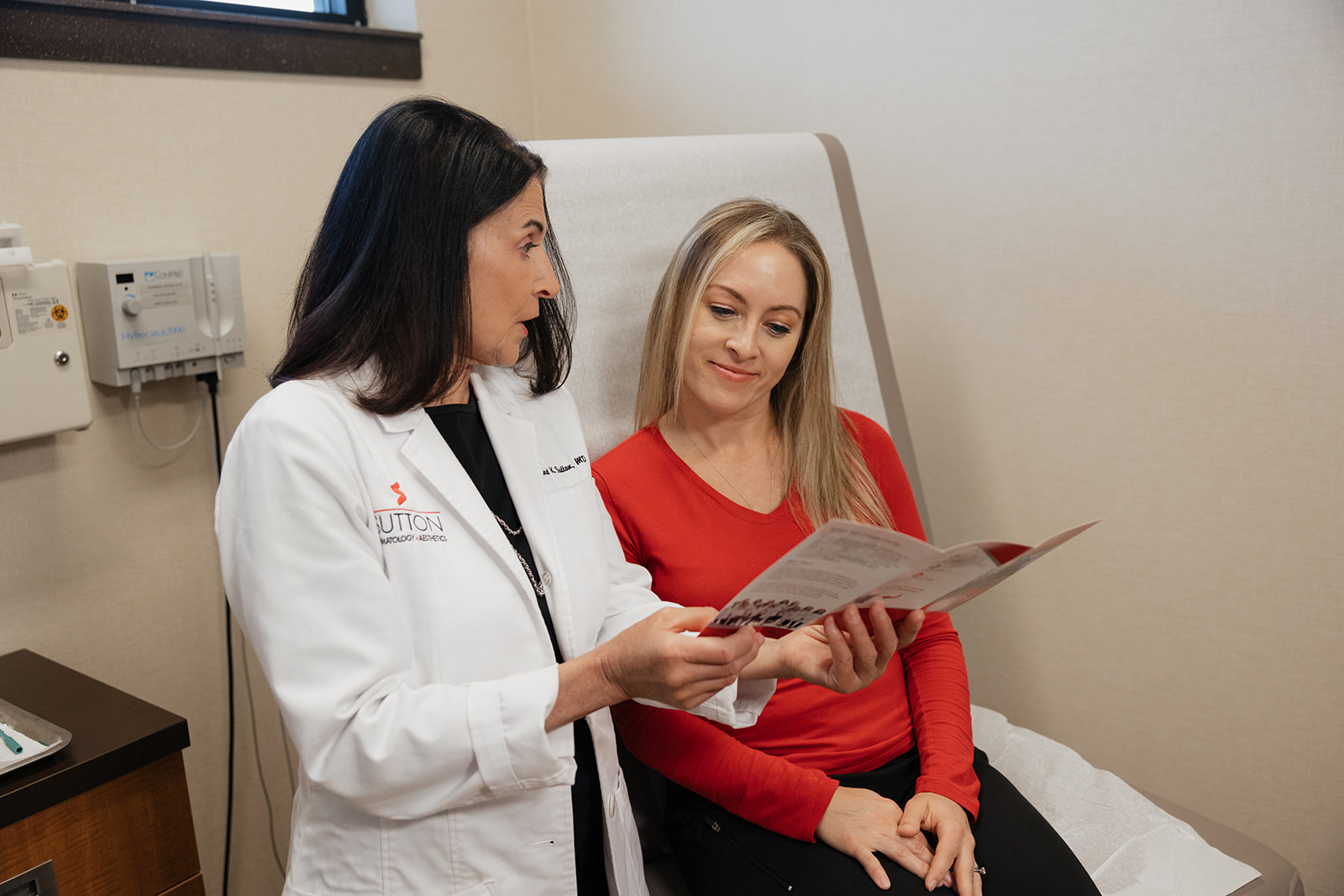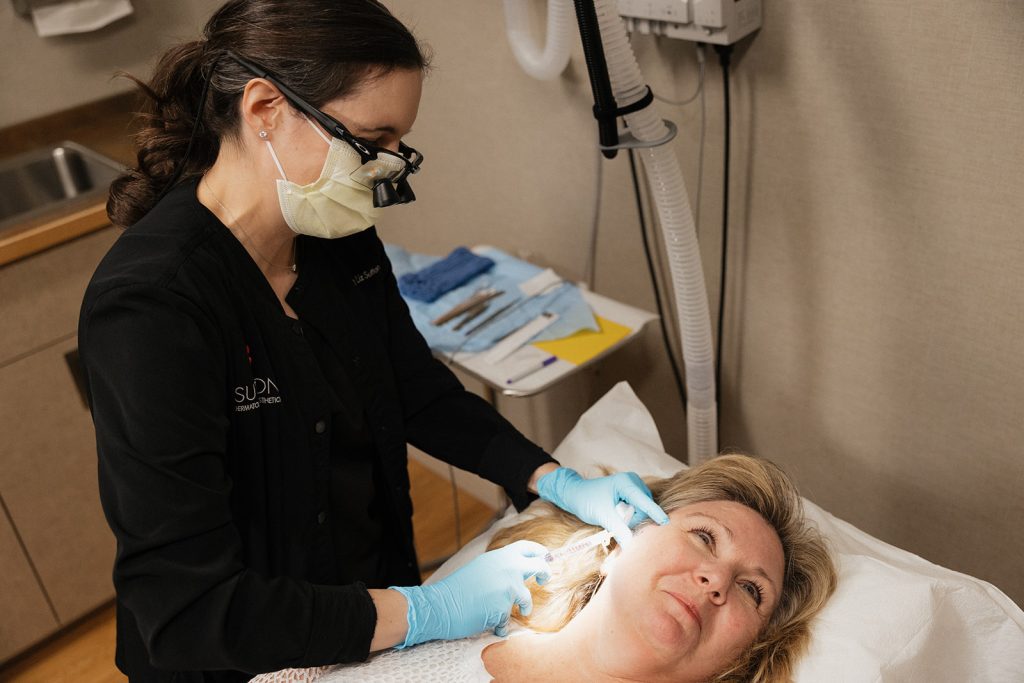Sutton Dermatology + Aesthetics
7100 Stephanie Lane
Lincoln, NE 68516
Phone: (402) 484-9009
Monday–Thursday: 8 a.m.–5 p.m.
Friday: 8 a.m.–3 p.m.
Sutton Dermatology + Aesthetics
5100 N. 26th Street
Lincoln, NE 68521
Phone: (402) 484-9009
Monday: 8 a.m.–5 p.m.
Tuesday: 8 a.m.–4 p.m.
Wednesday: 8:30 a.m.–5:30 p.m.
Thursday: 8:30 a.m.–4:30 p.m.
Friday: 8:30 a.m.–3 p.m.
Sutton Dermatology + Aesthetics
6900 L Street
Lincoln, NE 68510
Phone: (402) 484-9009
Monday: 8:30 a.m.–4:30 p.m.
Tuesday: 8 a.m.–5 p.m.
Wednesday: 8 a.m.–4 p.m.
Thursday: 8:30 a.m.–3:30 p.m.
Friday: 8 a.m.–3 p.m.
At Sutton Skin Cancer Center, our No. 1 priority is the outcome and experience of each patient. By familiarizing you with what to expect before, during, and after your procedure, we can help you prepare for your Mohs skin cancer surgery with confidence.
We encourage you to review the Mohs surgery resources below and contact our Sutton Skin Cancer Center team with any questions at (402) 484-9009. Our clinic serves patients from Lincoln, Grand Island, Omaha, and beyond.

The Basics of Mohs Skin Cancer Surgery
How To Prepare for Your Mohs Surgery
First, schedule your Mohs surgery. After you’ve been diagnosed with skin cancer, step one is to schedule your skin cancer surgery. A member of our triage team will assist you in reviewing your medical history, answering questions, and scheduling your surgery. Please consider upcoming personal events, such as vacations, weddings, or work requirements when scheduling your surgery.
Book your stay at a nearby hotel if you’re traveling from outside Lincoln. We offer many suggestions for a comfortable and convenient stay near our South or North clinics.
Prepare for surgery by taking the following actions and steps:

- Clear your schedule to allow ample time at our clinic on the day of your surgery.
- Get plenty of rest and eat a healthy breakfast before your procedure.
- Bathe or shower before surgery—treated skin must stay dry for 24 to 48 hours after your procedure.
- Take your daily meds and bring a list of all current medications.
- Bring your insurance and ID cards.
- Arrive 15 minutes before your scheduled surgery time.
- Bring a good book and your favorite device (with Air Pods) to pass the time while we prepare and study your tissue slides.
- Dress in layers—our surgery room can get a bit chilly.
- Review our map and directions to familiarize yourself with our location.
What To Expect the Day of Your Mohs Surgery
The removal of each layer of tissue takes approximately 1 to 2 hours. Only 5 to 10 minutes of that time is spent in the actual surgical procedure. The remaining time is required for slide preparation and evaluation of the tissue under the microscope. Removal of two or three layers of tissues (called “stages”) is usually required to completely remove the skin cancer. Therefore, if begun early in the morning, Mohs surgery is generally completed in 2 to 4 hours.
Here’s a more detailed overview of what to expect on the day of your Mohs surgery:
- Sign consent forms.
- Get comfortable in our surgical chair—remember, you’re in excellent hands.
- Your surgical site is cleaned.
- We take preoperative photos of the surgical site.
- We numb the surgical site with a local anesthetic.
- We perform your Mohs surgical procedure and remove the first stage (layer) of tissue.
- You pass the time as we process the tissue and evaluate it under the microscope.
- We communicate directly with you about our progress.
- We repeat the surgical and tissue analysis process as needed.
- Tissue removal is complete once the surgical site is cancer-free.
- We then close the surgical site, usually with sutures that need to be removed 1 to 2 weeks later.

What To Expect After Mohs Surgery
We’ll provide you with detailed post-op instructions following your Mohs surgical procedure. Remember, our team is only a phone call away if you have post-op questions or concerns. Some suggestions to care for your surgical site, prevent infection, manage comfort, and facilitate healing include:
- Some discomfort is expected after Mohs surgery. Take extra-strength Tylenol and other pain medications as instructed.
- Avoid exercising, lifting heavy items, and strenuous activity for 48 hours or until sutures are removed.
- If your surgical site is on the face, sleep with your head elevated and use ice packs to decrease swelling.
- Keep the surgical site dry and bandages on for 24 to 48 hours.
- Some blood-tinged drainage is normal. Remove and replace dressing as directed.
- Use plain water and mild soap to cleanse the treatment area.
- Always wash your hands before changing surgical dressings or touching the wound.
- Apply Vaseline® or Aquaphor® when redressing bandages.
- Cover the area with a clean bandage daily until sutures are removed.
When To Contact the Clinic
Contact our clinic right away if you notice any of the following issues or have additional concerns:
- Bright bleeding that persists after applying pressure for 20 minutes
- Increased drainage, pain, or redness that spreads beyond the treatment site
- Large, swollen, or tender areas around the treatment site (hematoma)
Will I Have Scars After Mohs Surgery?
While our experienced surgeons make every effort to minimize scarring, scars are inevitable when the skin barrier has been breached during Mohs surgery. Scar outcomes can differ based on factors such as the location of your procedure, skin type, and how your skin reacts to the healing process. Our Mohs team can provide information regarding scar treatment.
General Scar Care Tips
- Protect your skin from sun exposure.
- Sometimes, massaging your scar can improve its texture.
- Makeup is generally allowed 1 to 3 days after sutures are removed.
- Use a topical silicone gel or sheet to reduce scar appearance further—our team will provide product recommendations.
Mohs Surgery FAQ
Are Mohs surgery results permanent?
In most cases, the skin cancer removed by Mohs surgery is cured. It is important to note that patients who have had one skin cancer have an increased risk of developing another, separate skin cancer at some point in their lives. That is why we recommend regular skin examinations for patients with a history of skin cancer.
How long will redness and bumpiness last after Mohs surgery?
It is normal for redness to last anywhere from 2 weeks to 4 months. Bumpiness will continue to diminish over time. Both are important parts of wound healing.
Does insurance cover Mohs surgery?
Medicare and most insurance plans cover Mohs surgery. Exact coverage is subject to your specific insurance plan and deductible. We will review your billing and procedure costs with you before your Mohs surgery. It is important to contact the clinic if your insurance changes leading up to your surgery.
Why should I choose a fellowship-trained Mohs surgeon?
When choosing a Mohs surgeon, it is important that your surgeon has completed an ACGME-accredited Mohs micrographic surgery and dermatologic oncology fellowship. Both of our Mohs surgeons, Dr. Leigh Sutton and Dr. Elizabeth Sutton, completed ACGME-accredited yearlong Mohs micrographic surgery fellowships after their dermatology residencies. During their fellowships, they dedicated the entire year to advanced surgical training in Mohs micrographic surgery. They are both double board-certified in dermatology and micrographic dermatologic surgery and are members of the American College of Mohs Surgeons.
Mohs micrographic surgery requires a high degree of technical skill, surgical experience, and sophisticated clinical facilities—we offer all the above to ensure you have a safe and successful Mohs journey at Sutton Skin Cancer Center. We provide personalized, expert care every step of the way.
Schedule Your Appointment
Your safety, comfort, and results are our top priorities. Please reach out to our team with your questions and concerns at any time throughout the treatment process. Contact us online or by phone at (402) 484-9009.
Your Destination for Dermatology Excellence
Our three locations were designed with your comfort and convenience in mind.
Visit Our Locations






